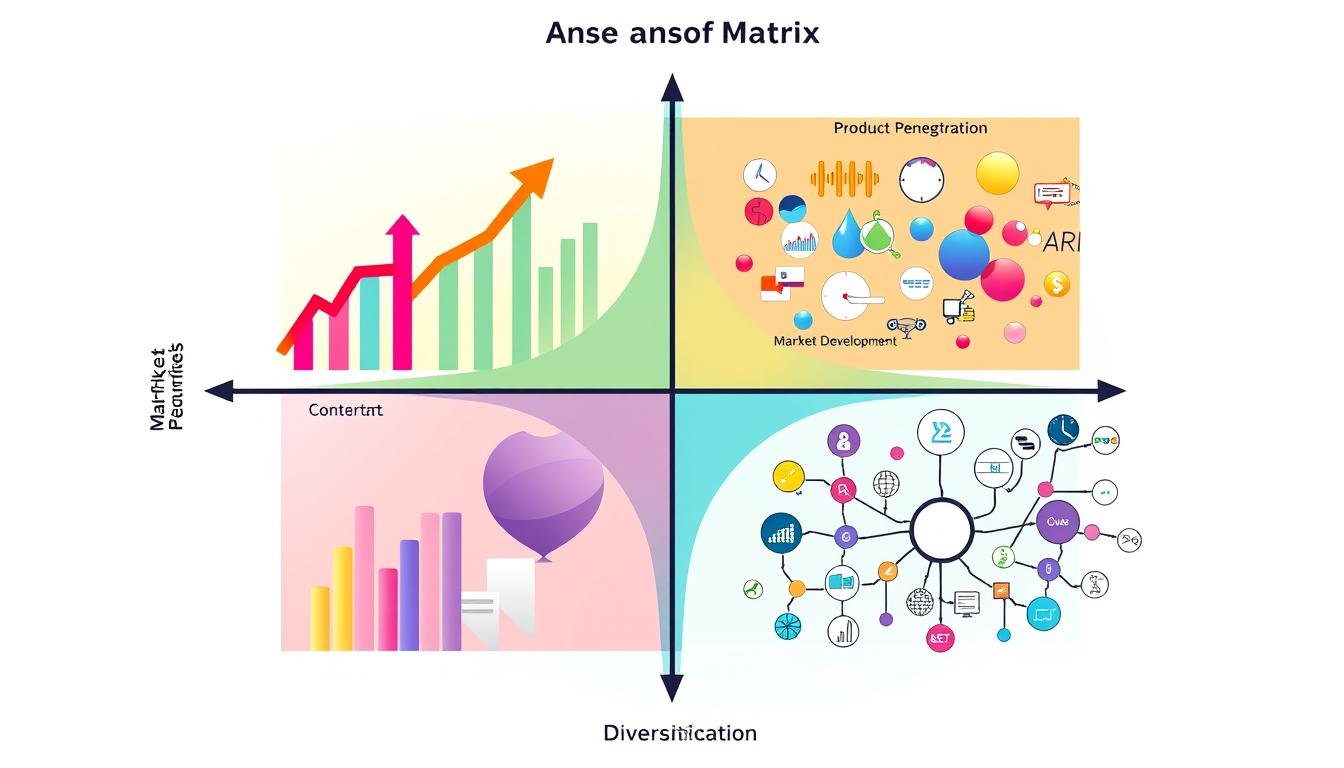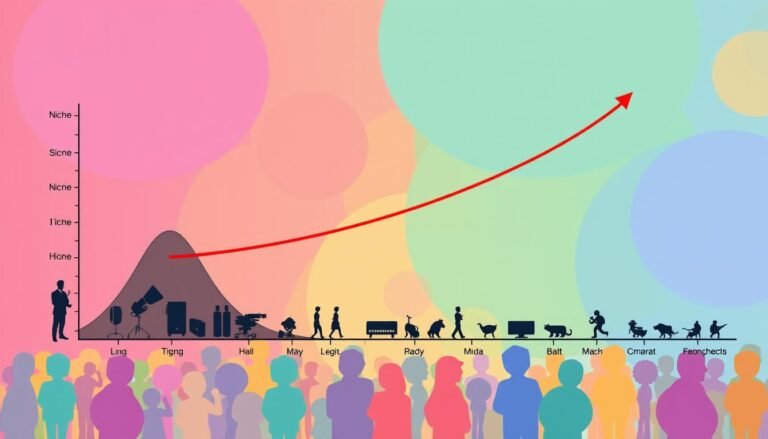Ansoff Matrix: Strategic Growth Planning Tool
Are you sure your business strategies are helping you grow? Or are you playing it safe and missing out on new chances? The Ansoff Matrix is a key tool for planning growth. It was created in 1957 by H. Igor Ansoff. It helps businesses grow by looking at new products and markets.
This matrix shows four ways to grow: Market Penetration, Product Development, Market Development, and Diversification. Each way has its own level of risk. It helps management teams make smart choices that fit their goals. Using tools like SWOT analysis and Porter’s Five Forces with the Ansoff Matrix gives a full view of how to grow a business.
Key Takeaways
- The Ansoff Matrix outlines four strategic growth options for businesses.
- Market Penetration is the least risky strategy, focusing on existing customers.
- Product Development emphasizes new products or enhancements to meet customer needs.
- Market Development seeks to introduce existing products to new markets.
- Diversification is the riskiest approach, involving new products in new markets.
- The Ansoff Matrix aids in risk assessment and strategic decision-making.
- Despite its benefits, the Ansoff Matrix has limitations in dynamic environments.
Introduction to the Ansoff Matrix
The Ansoff Matrix is key to understanding business growth strategies. H. Igor Ansoff introduced it in 1957 through the Harvard Business Review. It helps companies grow by offering four main strategies: Market Penetration, Market Development, Product Development, and Diversification.
This model is a simple 2×2 grid. It looks at product types and market segments. The vertical axis shows if the product is new or not, and the horizontal axis shows the market’s newness. Each section of the grid suggests a different strategy, helping leaders see risks and rewards.
Market Penetration is the safest strategy, aiming to sell more in current markets. Market Development is a bit riskier, focusing on selling current products in new places. Product Development is riskier still, as it involves creating new products for current markets. Diversification is the riskiest, requiring new products in new markets.
Using the Ansoff Matrix helps companies match their goals with what they can do. It shows which strategies drive growth and helps with financial planning. Tools like PESTEL, SWOT, and Porter’s 5 Forces also work well with it, making strategy planning better.
Knowing how the Ansoff Matrix works is key for businesses wanting to succeed. Companies like Starbucks have used Market Development to grow globally. Others, like Apple Inc., have succeeded with Product Development. The Ansoff Matrix helps make smart choices and leads to business growth.
Understanding the Four Quadrants of the Ansoff Matrix
The Ansoff growth matrix offers a structured way to look at market expansion strategies. It has four main areas, each with its own growth plan. Knowing these areas helps companies plan their growth based on the market and their own strengths.
- Market Penetration: This area is about selling more of what you already make in markets you know. For example, Coca-Cola sold more during Christmas by using strong marketing to boost sales.
- Market Development: Here, companies sell what they make now in new places. Coconut Water grew by targeting new customers in different markets.
- Product Development: This means making new products for your current customers. McDonald’s added healthier food options like the McSalad to meet changing customer needs.
- Diversification: This is the riskiest area, where companies make new products for new markets. Apple’s iPod and iPhone were big hits by reaching new customers.
By using these four areas wisely, companies can set clear goals and use their resources well for growth. This helps them plan their market moves ahead of time.
The Four Growth Strategies of the Ansoff Matrix
The Ansoff Matrix helps businesses find different ways to grow. Each strategy has its own risks and chances for success. This lets companies make smart choices based on what they want to achieve. Here are the four main strategies the matrix talks about.
Market Penetration
Market penetration means selling more of what you already make in the same markets. It’s the safest strategy because you’re working with customers you already know. Companies might use better marketing, prices, or ways to get their products to customers to sell more. For example, Coca-Cola uses more ads to get more people to buy their drinks.
Market Development
This strategy is about selling what you already make in new places. This could be in different countries or to new kinds of customers. Companies can find new customers this way. Lululemon, for instance, sells its yoga clothes in Asia to people who care about health.
Product Development
Product development means making new products for customers you already have. This makes customers more loyal and can increase the value of your brand. It often takes a lot of money to research and develop new products. For example, a health food brand might start selling organic snacks to keep up with what customers want.
Diversification
Diversification is the riskiest strategy. It means making new products for new markets. This can be done in ways that are related to what you already do, or it can be completely different. A shoe company might start making leather bags, for example. This spreads out the risk but needs careful planning.
| Growth Strategy | Description | Risk Level | Example |
|---|---|---|---|
| Market Penetration | Increase sales of existing products in current markets. | Low | Coca-Cola enhancing advertising efforts |
| Market Development | Introduce existing products to new markets. | Medium | Lululemon expanding into Asia |
| Product Development | Create new products for existing markets. | Medium | Health food brand launching organic snacks |
| Diversification | Launch new products in new markets. | High | Shoe manufacturer entering leather goods |
Benefits of Using the Ansoff Matrix
The Ansoff Matrix is a key tool for companies looking to grow. It offers a clear framework to find new opportunities and make strategic choices. This model helps in making decisions by offering a structured approach.
It brings many benefits like clear strategies, careful risk checking, and aligning with business goals. These aspects are crucial for success.
Strategic Clarity
The Ansoff Matrix makes strategic planning clear. It groups growth options into clear categories. This helps companies pick the best paths and avoid distractions.
With clear strategies, businesses can make better choices. They focus on the most promising areas for growth.
Risk Assessment
Managing risks is key to growing sustainably. The Ansoff Matrix helps assess risks for each strategy. Companies can see the challenges and plan better.
This approach improves decision-making. It helps in using resources wisely and understanding the risks involved.
Alignment with Business Objectives
For growth strategies to work, they must align with the company’s goals. The Ansoff Matrix ensures that growth plans support the main mission. This focus helps measure success and keeps everyone on the same page.
| Benefit | Description |
|---|---|
| Strategic Clarity | Helps businesses visualize growth options efficiently. |
| Risk Assessment | Enables thorough evaluation of risks tied to each strategy. |
| Alignment with Business Objectives | Ensures that growth strategies fit within core business goals. |
| Long-Term Planning | Facilitates planning for both immediate and future growth. |
| Flexibility | Can be adapted to fit various business sizes and industries. |
How to Apply the Ansoff Matrix in Your Business
Using the Ansoff Matrix in your business means planning carefully to grow. This method, created by H. Igor Ansoff in 1957, helps you see where you can grow.
- Assess Current Situation: Look at your products, where you stand in the market, and what you can do well. This helps you see your starting point.
- Identify Growth Opportunities: Look for chances to grow in each quadrant. Use what you’re good at and watch the market for trends.
- Evaluate Risks and Returns: Study each growth option carefully. Think about how much people want it and who else is doing it. It’s important to know the risks.
- Prioritize Strategies: Pick the strategies that make the most sense. Focus on those that are likely to work and fit with your business goals.
- Develop Implementation Plan: Make a plan that shows how you’ll use resources, when things will happen, and how you’ll check success.
- Monitor and Adapt: Keep an eye on how your growth plans are doing. Be ready to change them if needed, based on what’s happening in the market.
Using the Ansoff Matrix helps companies grow with a clear plan. It helps them stay flexible in a changing market.
Ansoff Matrix in Strategic Management
The Ansoff Matrix is a key tool for strategic management. It helps businesses find new growth areas by matching their products with market chances. Companies use the matrix to look into strategies like Market Penetration, Market Development, Product Development, and Diversification. This method makes decision-making clearer.
For example, RS Components used the Ansoff Matrix to start an online sales website for individual buyers. This move reached new customers and boosted their online image. Argos also found new business chances online using the framework. These stories show how the Ansoff Matrix helps with planning in the digital world.
Using the Ansoff Matrix helps companies improve their strategic management. They can think deeply about their market spot and growth plans. A data-driven marketing approach, like the RACE Framework, can help get and keep customers. It’s important for businesses to keep up with changes, as sticking with old products can slow growth.
As things change, knowing the risks of each growth strategy is key. Market penetration is the safest, while diversification is the riskiest. Each strategy needs different skills and market knowledge. This shows the importance of a customized approach in strategic management.
| Growth Strategy | Risk Level | Key Considerations |
|---|---|---|
| Market Penetration | Low | Increase sales volume to existing customers or find new customers within the same market. |
| Product Development | Medium | Requires additional skills and processes to support new offerings. |
| Market Development | Slightly Higher | Efforts needed to understand new markets and gain market share. |
| Diversification | High | Involves departure from existing product lines and market structures. |
Conclusion
The Ansoff Matrix is key for companies wanting to grow in today’s fast-changing business world. It helps leaders make smart choices by offering four main strategies. These include Market Penetration, Market Development, Product Development, and Diversification.
Nike uses market penetration by teaming up with famous athletes. Apple focuses on product development by always bringing out new iPhone models. This shows how the Ansoff Matrix helps in making strategic decisions.
The Ansoff Matrix also highlights the need to assess risks and be clear about strategies. IKEA grows by entering new markets, while Heineken and Coca-Cola use strong marketing to reach more people. Market penetration is seen as less risky, but other strategies come with different risks and rewards.
Diversification is the riskiest but can also be the most rewarding. Using the Ansoff Matrix helps companies grow, innovate, and meet their goals. It guides them in making the right moves to stay ahead in a changing market.
Source Links
- Ansoff Matrix 101: The 4 Strategies for Growth and Expansion
- Applying the Ansoff Matrix in Strategic Planning — Helping Companies Deliver More Value Through Better Process Management | Bob Stanke
- Ansoff Matrix
- How to Use Ansoff Matrix For Successful Business Strategies | Lucidity
- Ansoff Matrix: Product Management & Operations Explained
- The Ansoff Matrix: 4 Growth Strategies Explained (With Examples)
- No title found
- Ansoff Matrix: Growth Strategies, Challenges & Benefits
- The Ansoff Matrix: the marketing matrix to create your growth strategy – Templates | Klaxoon
- The Ansoff Matrix: A Powerful Tool for Business Strategy and Growth
- Analysis and Advantages of Ansoff Matrix
- Ansoff matrix: what it is, and how to use it | MindManager Blog
- Using the Ansoff Matrix to Plan Market Strategy
- The Ansoff Model [Marketing strategy matrix] | Smart Insights
- Ansoff Matrix Explained – SM Insight
- What is an Ansoff Matrix? | High Alpha
- Ansoff Matrix
- Exploring the Ansoff Matrix: Strategies for Business Growth







